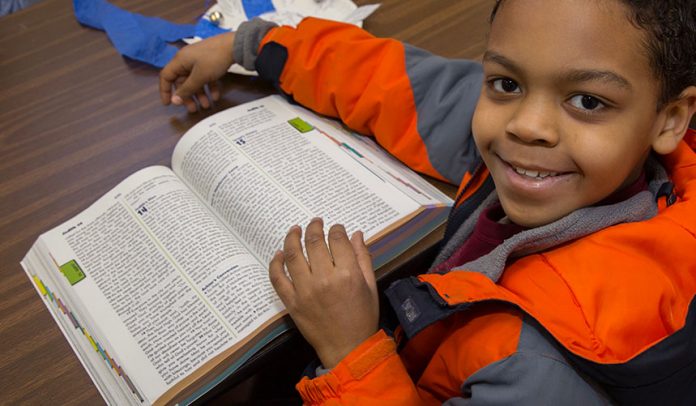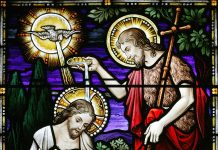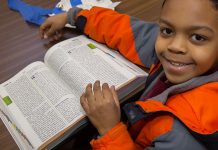
by Kate Ristow
See the end of this article for a Bible blessing to use during Mass or in the classroom.
The fifth graders were called forth from the pews after the homily. Most approached the altar solemnly, others nonchalantly, some nervously looked about. Parents positioned themselves near the sanctuary to record the big moment on video cams and cell phones.
As catechists called names, the children went to the pastor and received a Bible. When each child had a copy of the Sacred Scriptures, the pastor invited the children to face the assembly. He asked several questions about how they would treat God’s Word. He then encouraged the assembly to extend our hands and join him in blessing the Bibles and the children.
As the children returned quietly to their places, I couldn’t help but think, “What will happen to these Bibles now? How will catechists help the kids ‘get into’ the Scriptures?”
Here are some strategies for working with the Bible in your classroom and enabling your students to recognize God’s Word as a lifelong resource for growing in faith.
1. Bible Enthronement
Before class begins, set up a small prayer table that the children will decorate during the ritual. You will need a large Bible, a Bible stand, a fabric table covering that reflects the season, and two candles.
Tell the children that they are going to give the Bible a place of special honor in the classroom in a prayer celebration called a “Bible Enthronement.” Prepare by having the children practice singing a familiar Alleluia Acclamation verse. Choose volunteers to carry the fabric, the candles, the Bible stand, and the Bible to the prayer table.
Invite the children to form a single-file line for a procession from outside the classroom to the prayer area. Instruct students carrying the fabric, the candles, the Bible stand, and the Bible to take their places at the end of the line. Show the child carrying the Bible how to reverently elevate it as it is carried.
Enter the classroom in procession, singing. Have the children gather around the prayer table and silently watch as the fabric, candles, Bible stand and Bible—in that order—are placed on it.
Make the Sign of the Cross together. Proclaim Isaiah 40:8 aloud: “Though the grass withers and the flower wilts, the word of our God stands for ever.” Demonstrate how to show respect for the Bible by bowing before the Scriptures or placing your hand reverently on it. Then encourage the children to do the same. Invite the children to echo the following prayer: “Help us to love and learn from your Word, O God. May its teachings always have a special place in our hearts, our words, and our actions. Amen.” Conclude by singing again the Alleluia refrain.
2. Locating Scripture Passages
Prepare for this activity by listing five or more Scripture passages on poster board. Select passages that are preceded with a title. For example, see Luke 2:1. It is preceded with “The Birth of Jesus.” See Exodus 14:10. It is preceded with “Crossing of the Red Sea.” Select five such citations but write only the citations on the poster board, not the titles.
Invite the children to turn to the contents page in their Bibles. Have them name the two main parts of the Bible (The Old Testament and The New Testament).
Briefly explain that the Old Testament tells the story of Creation and God’s Covenant with his chosen people, the Israelites. Point out that the New Testament tells the story of Jesus and the early Church.
Explain that the Bible is composed of 73 books, that each book is divided into chapters, and that the chapters are divided into verses of one or more sentences. Then help children find Genesis 1:1, and read aloud the title, “First Story of Creation.”
Distribute notebook paper and have the children locate the passages you listed on the poster board. Direct them to write the title for each passage. This exercise will help the children become proficient at finding their way around the books of the Bible.
3. Using the Study Aids
Most Bibles have a number of features that help readers better understand and appreciate the content and context of the Scriptures. These may include maps, photographs, a Bible dictionary, a list of abbreviations used for the books of the Bible, a doctrinal Bible index, cross references and notes at the bottom of each page, and so forth.
Study the Bible you will use with your students to become aware of the various study aids. When you introduce the Scriptures to the class, point out a few of these valuable resources and tell the children that they will learn about other features during the year. Keep in mind that these features will help the children only if you utilize them during your lessons.
4. Profiles in Faith
Create a list of important figures in salvation history: Noah, Abraham, Joseph, Moses, King David, Jeremiah, Mary, Joseph, Saul/Paul, Peter and the other Apostles, Elizabeth, John the Baptist, Simeon, the Good Thief, and so forth. Working with students who have some familiarity with both the Old and the New Testament, have each child chose a name from the list and write a one-page report on how that person is an example to us of living as God asks us to live.
Assign a due date for the reports that gives the children time to read about the person in their Bibles and to research the Internet at home to prepare their faith profiles.
5. Retelling the Story
The best way to learn and remember a Scripture story is to retell it after hearing it proclaimed. There are countless ways to enable your students to retell a Scripture story.
Dramatizing the story works well with uninhibited primary-aged students, as does using manipulatives, such as flannel-board figures or the wooden figures suggested in the Catechesis of the Good Shepherd program. These props are invaluable tools in retelling a story.
Older students will enjoy and learn from the experience of preparing a Scripture play for younger students or their parents. Children of all ages can sculpt a figure or symbol from self-drying clay to illustrate the central point of a particular story.
Another way to engage younger children in the Scriptures is to have them use rhythm band instruments to accompany excerpts from a joyful psalm you study in class, such as Psalm 22, 33, 66, or 148. Encourage the children to make a joyful noise as they echo a verse from the psalm.
6. Thematic Music
Divide the class into small groups and give each group a hymnal borrowed from church. Hopefully, your parish uses a hymnal that includes both a topical index and a first-line index.
As you study a seasonal Scripture story, such as one of the Easter or post-Resurrection accounts, have each group find a hymn that relates to the Scripture. This also works well with other seasons of the Church year and themes such as the Holy Trinity, the Most Holy Body and Blood of Christ, and so forth.
Before assigning this project to the class, do your homework by locating possible hymns on your own to coordinate with your lesson. If you are unable to find a musical connection, don’t frustrate the kids by asking them to do the assignment. There will be other opportunities throughout the year that will enable them to find many connections between the Scripture and Church music.
7. Memorization
While you won’t want your students to memorize every Scripture, here are a few examples you might consider: the Great Commandment (Luke 10:27); the Beatitudes (Matthew 5:3-10); Psalm 23; Love is… (1 Corinthians 13:4-13).
You can also invite students to learn by heart short passages from Scripture: “Take and eat; this is my Body” (Matthew 26:26); “Live as children of light” (Ephesians 5:8); and other pertinent verses for your grade level.
8. Comparing and Contrasting
Older students will benefit from using the cross-references in their Bibles to study different Scriptural accounts of the same story and note similarities and differences. For example, have them note that the only miracle story told in all four of the Gospels is the Feeding of Five Thousand (Matthew 14:13-21; Mark 6:34-44; Luke 9:10-17; called “Multiplication of the Loaves” in John 6:1-15).
Another fruitful research project for junior high students is to have them study the Four Gospels in small groups and put the Resurrection and post-Resurrection accounts in the most logical order. Note the word “logical.” Scripture scholars have spent years pondering these events and the order in which they occurred. The point for your students is to see the totality of Jesus’ final days with his disciples and to understand that each Evangelist came at his Gospel from a different source and perspective.
9. Creative Writing, Bible-Style
Many forms of writings are found in the Scriptures—everything from stories to history to poetry to prayers. Inspire your students to try their hand at writing one of these genres.
For example, after studying a psalm, you might invite students to write an original psalm praising God for all the blessings in their lives. After reading excerpts from one of St. Paul’s letters, challenge students to work in small groups to compose a letter to young people their own age about how they can best live their faith. Working in groups will lessen the pressure and help students build on one another’s ideas. If at all possible, arrange to mail these “epistles” to a religious education class at a neighboring parish.
Another writing project begins by studying the Book of Proverbs with the class. Then have students work in pairs to create two original sayings that might help someone their age live according to God’s plan or to make good decisions. Have the kids post their work on placards that can be displayed in public areas of the parish.
10. Bible Fair for Families
Work with a team of catechists and parents to plan a day-long Bible fair for families. For example, you might ask one member of the planning team to recruit volunteers to learn about games families played together in biblical times, and then staff a games area at the Bible fair.
Another group of volunteers can prepare dramatizations of one or more favorite Gospel stories, complete with costumes.
Ask a third member of the team to organize a refreshment team that will serve treats with a Mediterranean theme: grapes, apple slices, cheese cubes, pita bread, grape jelly, mild guacamole, and/or yogurt dip, raisins, fig newtons, white grape juice, and so forth.
Plan a craft area for the day. For example, families might make palm crosses or decorate pillar candles with biblical symbols. Additional ideas for activities can be adapted from vacation Bible school resources from the shelves of your religious education center.
Be sure to invite one member of your team to plan a closing prayer to send families forth, rededicated to God’s Word and living their faith.
The point is for families to have fun together while focusing on the importance of the Sacred Scriptures in our lives. Avoid preaching. Allow time for mingling and talking. Make it a day to remember that “In the sacred books, the Father who is in heaven comes lovingly to meet his children, and talks with them” (Catechism of the Catholic Church, n.104).
Kate Ristow, Contributing Editor to CATECHIST, has worked in Catholic publishing for over 25 years as a national speaker and writer, building on a wealth of experience in the religious formation of children and catechists in both parish and Catholic school programs.
A Ritual for the Reception and Blessing of Bibles
Materials needed:
* a Bible for each student
* a small bowl of blessed water
If this ritual is celebrated during a parish Mass, ask the presider to announce that Bibles will be blessed and presented to the children in grade __ following the homily. If the ceremony is being celebrated in the classroom, gather the children in the prayer area.
The Leader calls each student forward by name and presents each one with a Bible saying, “[Child’s name], take this Bible and rejoice in its Good News.” After all have received their Bibles, the Leader asks the children to hold up their Bibles in both hands, elevating them. The Leader then asks the following questions, inviting the children to respond “We will” to each.
Leader: Will you treat God’s Word with love and respect?
All: We will.
Leader: Will you grow in your faith by reading God’s Word often?
All: We will.
Leader: Will you learn from God’s Word and share it with others?
All: We will.
The leader then blesses the Bibles with holy water:
Leader: Loving Father, on behalf of [name of parish], we ask you to bless these Bibles. May the young people who receive them grow in wisdom and grace through your Holy Word.
All: Amen.
Invite the children to open their Bibles and read together Psalm 119: 89-90, 97, 105. Allow time for the children to find the psalm.
All: Your word, Lord, stands forever,
it is firm as the heavens.
Through all generations your truth endures;
fixed to stand firm like the earth.
How I love your teaching, Lord!
I study it all day long.
Your word is a lamp for my feet,
a light for my path.
Amen.
Copyright 2011, Bayard, Inc. All rights reserved. This article is protected by United States copyright and other intellectual property laws and may not be reproduced, rewritten, distributed, redisseminated, transmitted, displayed, published or broadcast, directly or indirectly, in any medium without the prior written permission of Bayard, Inc.




